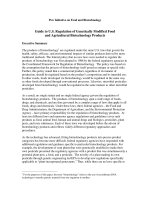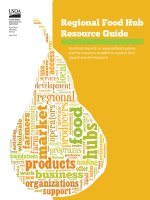S3O1 food guide pyramid
Bạn đang xem bản rút gọn của tài liệu. Xem và tải ngay bản đầy đủ của tài liệu tại đây (780.15 KB, 38 trang )
My Pyramid Basics and Dietary
Guidelines
Anatomy of My Pyramid
Activity
Activity is represented by the steps and the person climbing them, as a reminder of the importance of daily physical activity.
Moderation
Moderation is represented by the narrowing of each food group from bottom to top. The wider base stands for foods with little or
no solid fats or added sugars. These should be selected more often. The narrower top area stands for foods containing more
added sugars and solid fats. The more active you are, the more of these foods can fit into your diet.
Personalization
Personalization is shown by the person on the steps, the slogan, and the URL. Find the kinds of amounts of food to eat each
day at MyPyramid.gov
Proportionality
Proportionality is shown by the different widths of the food group bands. The widths suggest how much food a person should
choose from each group. The widths are just a general guide, not exact proportions. Check the Web site for how much is right
for you.
Variety
Variety is symbolized by the 6 color bands representing the 5 food groups of the
Pyramid and oils. This illustrates that foods from all groups are needed each day
for good health.
Gradual Improvement
Gradual improvement is encouraged by the slogan. It suggests that individuals can
benefit from taking small steps to improve their diet and lifestyle each day.
Food Intake Patterns
Calorie
Level
1,000
1,200
1,400
1,600
1,800
2,000
2,200
2,400
2,600
2,800
3,000
3,200
Fruits
1 cup
1 cup
1.5
cups
1.5
cups
1.5
cups
2
cups
2
cups
2
cups
2
cups
2.5
cups
2.5
cups
2.5
cups
Vegetables
1 cup
1.5
cups
1.5
cups
2
cups
2.5
cups
2.5
cups
3
cups
3
cups
3.5
cups
3.5
cups
4
cups
4
cups
Grains
3 oz
4 oz
5 oz
5 oz
6 oz
6 oz
7 oz
8 oz
9 oz
10 oz
10 oz
10 oz
Meat and
Beans
2 oz
3 oz
4 oz
5 oz
5 oz
5.5 oz
6 oz
6.5 oz
6.5 oz
7 oz
7 oz
7 oz
Milk
2
cups
2
cups
2
cups
3
cups
3
cups
3
cups
3
cups
3
cups
3
cups
3
cups
3
cups
3
cups
Oils
3 tsp
4 tsp
4 tsp
5 tsp
5 tsp
6 tsp
6 tsp
7 tsp
8 tsp
8 tsp
10 tsp
11 tsp
Discretionary
calorie
allowance
165
171
171
132
195
267
290
362
410
426
512
648
Nutrients – Energy Producing
Carbohydrates
• Provides Energy
Protein
• Builds and Repairs Body Tissue
Fat
• Insulation, Protection, Reserve Energy
Nutrients –
non energy producing
Vitamins
•
Minerals
•
Skeletal structure
Water
•
Assists in the biochemical reactions related to the
metabolic process
Hydration, most essential to life
Fiber
•
Digestion of food
Grains
Servings Daily: 3-10 ounces
Major Nutrient: Carbohydrates, Fiber
Serving: 1 oz = 1 slice bread – 1 cup dry cereal =
½ cup pasta
or rice
Tips: eat at least 3 oz
of whole grains each day
Vegetables
Servings Daily: 1-4 cups
Major Nutrient: Vitamins, Fiber
Serving: Eat a variety of colors
Tips: Eat more dark green
and orange vegetables,
eat more dry beans
and peas
Fruits
Servings Daily 1-2 ½ cups
Major Nutrient: Vitamins, Fiber
Serving: 1 medium/small piece of fruit = 1 cup
Tips: eat a variety of fruit,
go easy on juices
Milk
Servings Daily 2-3 cups
Major Nutrient: Minerals, Protein
Serving 1 ½ oz cheese – 1 cup milk/yogurt
Tips: go low-fat or
fat free, it you can’t
consume milk, choose
other calcium sources
Meat and Beans
Servings Daily: 2-7 ounces
Major Nutrient: Protein
Serving: 1 oz meat = 1 egg = 1 T peanut butter =
¼ cup cooked beans = ½ oz nuts or seeds
Tips: choose low fat or lean
meats, bake, broil or grill.
Vary protein.
Oils
Servings Daily: 3-11 teaspoons
Major Nutrient: Fat
Serving: Watch for it in foods such as nuts, olives,
mayonnaise, salad
dressing
Tips: Use canola, olive, peanut, soybean, corn
safflower or
sunflower oil.
Fats and Oils
Fats are solid at room temperature and oils are
liquid.
Consume less than 10% of calories from saturated
fatty acids and less than 300 mg of cholesterol.
Keep trans fatty acid consumption as low as
possible.
Choose meat and dairy products that are low in
fat.
Sugar
Keep sugar within the discretionary calorie
allowance.
Choose water or fat free milk
to drink.
Limit sweet snacks and
desserts.
Select unsweetened cereals.
Discretionary Calorie Allowance
The calories remaining after
accounting for the calories
needed for all the food groups.
These can be used up with
poor food choices in the
pyramid or saved for a
real treat!
Physical Exercise
Be physically active for at least 30 minutes a day.
About 60 minutes a day of physical activity may be
needed to prevent weight gain.
For sustained weight loss at least
60-90 minutes of physical activity
is needed.
Children and teenagers should
be physically active for 60 minutes
every day!
The Dietary Guidelines
1. Get adequate nutrients
within the calorie needs
Caloric Breakdown
Carbohydrates: 55-60%
Fat: No more than 30%
Protein: 10-15 %
Average American eats too
much fat, sugar, calories &
sodium
Average American doesn’t eat
enough fiber.
2. Manage weight, balance food
intake with exercise output
Serving Size Quiz
What does a serving size look like?
QUIZ: What Makes a Serving?
•
A huge bag of Ruffles is helping you get through
your science homework. You polish off about ½
a bag or 50 chips. How many servings of chips
have you just eaten?
A.
1
B.
2 1/2
C.
5
The Answer: C
An official serving of Ruffles is one ounce, which is
about 10 chips. Half a bag is 5 servings.
QUIZ: What Makes a Serving?
One serving of steak is about as big as:
A.
A deck of cards
B.
A Howie Day CD
with case
c.
A paperback book
The Answer: A
An official serving of steak is three ounces or
about as big as a deck of cards. A typical slab you
would get at a steak house would be five times
that size.
QUIZ: What Makes a Serving?
According to the label on a package of Oreos,
one serving has 100 calories and five grams of
fat. How many cookies are
in a serving?
A.
1
B.
2
C.
3
The Answer: B
An official serving of Oreos is 2 cookies. But who
can stop at just 2?









